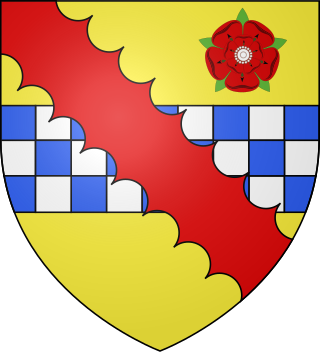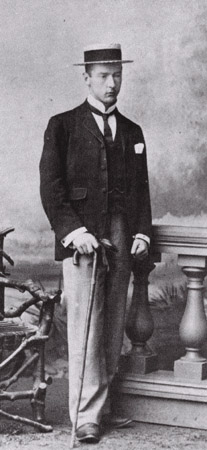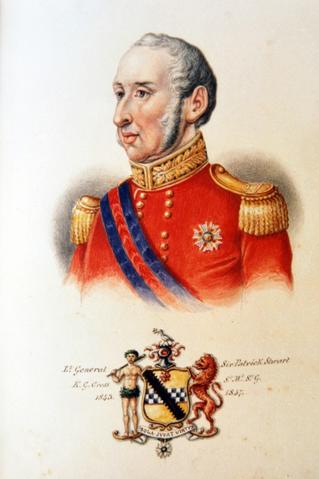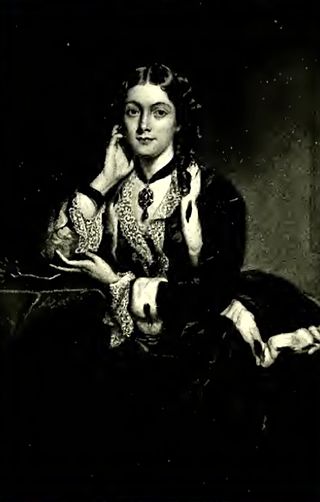
Earl of Airlie is a title of the peerage in Scotland created on 2 April 1639 for James Ogilvy, 7th Lord Ogilvy of Airlie, along with the title "Lord Ogilvy of Alith and Lintrathen". The title "Lord Ogilvy of Airlie" was created on 28 April 1491.
The 47th (Lancashire) Regiment of Foot was an infantry regiment of the British Army, raised in Scotland in 1741. It served in North America during the Seven Years' War and American Revolutionary War and also fought during the Napoleonic Wars and the Crimean War. Under the Childers Reforms it amalgamated with the 81st Regiment of Foot to form the Loyal Regiment in 1881.
Hugh Charles Clifford, 7th Baron Clifford of Chudleigh was a British peer and author.

Lord Blantyre was a title in the Peerage of Scotland. The Scottish feudal barony of Blantyre was first documented in the 13th century. In 1606, it was elevated into the Peerage of Scotland for the politician Walter Stewart, who was thus made a Lord of Parliament. The lordship was named for Blantyre Priory in Lanarkshire, where Walter Stewart had been commendator. The main residences associated with the Lords Blantyre were Erskine House (Renfrewshire) and Lennoxlove House.

Walter Stewart, 1st Lord Blantyre (1555–1617) was a Scottish courtier and politician. He was Keeper of the Privy Seal of Scotland from 1582 to 1596 and Treasurer of Scotland from 1596 to 1599.

Archibald FitzRoy George Hay, 13th Earl of Kinnoull, styled Viscount Dupplin from 1886 until 1897, was a Scottish peer and soldier. His titles were Earl of Kinnoull, Viscount Dupplin and Lord Hay of Kinfauns in the Peerage of Scotland; and Baron Hay of Pedwardine in the Peerage of Great Britain.

John Charles Ogilvie-Grant, 7th Earl of Seafield,, styled Viscount Reidhaven from 1840 to 1853, was a Scottish nobleman. He is numbered as the 26th Chief of Clan Grant.

Captain James Ogilvie-Grant, 11th Earl of Seafield,, styled Viscount Reidhaven in 1888, was a Scottish peer and soldier. He is numbered as the 30th Chief of Clan Grant.

Clan Ogilvy, also known as Clan Ogilvie, is a Highland Scottish clan. Originating from Angus, Scotland, the progenitor of the Clan received a barony from King William the Lion in 1163. In 1491, King James IV elevated Sir James Ogilvy as Lord Ogilvy of Airlie.
Lt.-General Godfrey Bosville Macdonald, 3rd Baron Macdonald of Sleat was a Scottish aristocrat.

Major-General Sir Guy Campbell, 1st Baronet, was a British Army officer. His branch of the Campbell baronets is referred to as St Cross Mede.

Charles Murray, 1st Earl of Dunmore PC was a British peer, previously Lord Charles Murray.

Ian Charles Ogilvie-Grant, 8th Earl of Seafield, styled Viscount Reidhaven from 1853 until 1881, was a Scottish nobleman. He is numbered as the 27th Chief of Clan Grant.

Charles Stuart, 12th Lord Blantyre,, styled Master of Blantyre from birth until 1830, was a Scottish nobleman and landowner with 14,100 acres (57 km2) of titled lands.

Charles Morgan Robinson Morgan, 1st Baron Tredegar, known as Sir Charles Morgan Robinson Morgan, 3rd Baronet from 1846 to 1859, was a Welsh Whig peer and a member of the House of Lords.
The Hon. Sir William Stuart, was a British diplomat who served as Minister to Argentina, Greece and The Netherlands.

General Sir Patrick Stuart, was a British Army officer who served as Governor of Malta between 1843 and 1847.

Lieutenant-General William Stuart, (1778–1837) was a British Army officer who fought in the Napoleonic Wars.

John Ruaridh Grant Mackenzie, 5th Earl of Cromartie is a Scottish engineer and peer. He is the current chief of Clan Mackenzie.

Caroline Stuart, Countess of Seafield, styled as the Countess Dowager from 1884 to 1911, was a member of the Scottish aristocracy. She was suo jure proprietor of the Seafield estates following the death of her son in 1884, and thus was de facto Chieftainess of Clan Grant. She has been described as the "last of the great feudal chiefs."
















